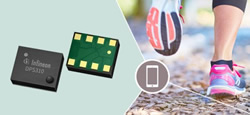Description
Low-power, high-accuracy pressure sensing for battery operated wearable devices
With more and more applications requiring high-accuracy atmospheric pressure data, engineers are seeking ever-more sensitive pressure sensing methods. New sensor technologies that are based on capacitive sensing enable engineers to create miniaturized and very accurate devices while satisfying demanding energy constraints and addressing reliability challenges.
Fitness monitoring wearables are a large part of a growing variety of products and applications require the high-accuracy sensing of static and dynamic air pressure. As these applications are typically found in batteryoperated devices, it is also essential to combine the high accuracy with optimized low-power operation and reliability across a broad range of operating conditions.
Many existing small form-factor MEMS (Micro Electro-Mechanical System) pressure sensors are built around piezo-resistive measurement techniques. In these cases, the flexing of a diaphragm in relation to changes in pressure is sensed via a strain sensor. However, piezo-resistive sensing elements are particularly susceptible to variation with temperature changes and they do not respond linearly to temperature. For this reason, piezoresistive sensors have a need for more complex calibration compared to a capacitive element. In addition, resistive measurement can represent a significant drain on power – a particularly important consideration when the target application is battery-powered and operating lifetime is critical.
By Sampo Härkönen, Senior Manager Pressure Sensor Marketing, Infineon Technologies
Download and read the full whitepaper below.
| Part Number | Name | Companion Part | |
|---|---|---|---|
| DPS310XTSA1 | DPS310XTSA1 | Buy Datasheet | |
| KIT DPS310 2G SHV02 | KIT DPS310 2G SHV02 | Buy Datasheet |
